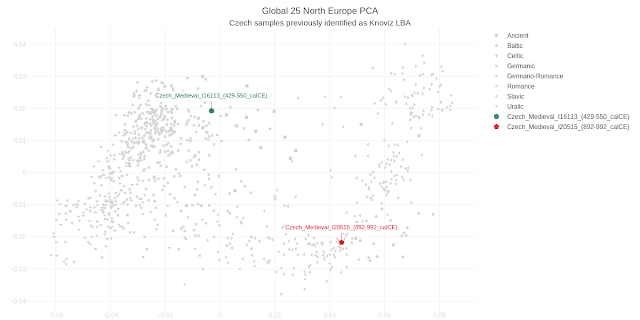Genetic diversity of the early Slavs
For some reason there are plenty of people who strongly believe that only the samples with the highest Baltic BA-like ancestry can be representative for a Proto-Slavic population. According to them any deviation from this Baltic genetic profile eliminates given individual from a pool of potential Proto-Slavs.
Such reasoning is wrong on so many levels and ignores so much of the already published data, that I don't know if even a dozen of blog posts will be enough to deal with these shenanigans.
But for now let's focus on one simple aspect - that certain samples can't be representative for the Proto-Slavic population just because they don't look like Balts (sic!).
Below you can see a North European PCA with Lithuanians and some early Slavic samples plotted on it. Lithuania is a small country, with a small population, and is genetically rather homogeneous. This is quite clearly visible on this PCA, where Lithuanians form a tight cluster.
Now, if you draw a circle around Lithuanians and move it on top of the early Slavs you can observe that nearly all of them, who don't have Balkan admixture, fit into this shape.
In other words - if Lithuanians are Lithuanians, if they form a small population from a small country, speaking one language, then without any hesitation we can say that both CZE_Early_Slav:RISE569 and Krakauer Berg may represent the same small population from a small area that speaks a single language.
Moreover we can say that the observed differences between them are mainly due to the genetic gradients that existed in the ancestral population well before any migrations, and not due to the incorporation of some non-Slavic substrates.




Comments
However, if we accept together the erroneous concept of some colleagues for a moment that the individuals in the blue circle are descendants of the individuals in the green circle with the local population, then on the left we have to draw the same circle of local individuals. It will still remain in the contemporary Slavic cluster. In other words: the locals will have a lot of Balto-Slavic drift.
Yeah, it's hard to believe that the assimilation of Balts did not leave any mark in the autosomal DNA.